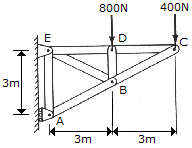Determine the force in each member of the truss and indicate whether the members are in tension or compression.

Solution
First consider a free body diagram for the whole truss structure to find the reactions at supports E and A by applying the equations of equilibrium for its external forces.
So taking summation of moment about E = 0, 3Ra-3(800)-6(400) = 0.
Ra = 1600 N.
Sum of horizontal forces = Re(x)-800-400 = 0; Re(x) = 1200 N.
Sum of vertical forces = Re(y)-Ra = 0; Re(y) = 1600 N.
Considering each member force to be a tension, each joint will be analyzed so taking joint C,
Sum of horizontal forces = 400+F(CB) sin(26.57) = 0, F(CB) = -894 N T or F(CB) = 894 N C.
Sum of vertical forces = -F(CB) cos (26.57)-F(CD) = 0; F(CD) = 800 N T.
At joint D, F(DC) = F(DE) = 800 N T F(DB) = -800 N T = 800 N C.
At joint E, Sum of vertical forces = F ED)+F(EB) sin(63.43)-Re(y) = 0.
F(EB) = (Re(Y)-F(ED))/sin(63.43) = 894 N T.
Sum of horizontal forces = F(EA) = F(EB) cos(63.43) = Re(x).
F(EA) = 1200-894 cos(63.43) = 800 N T.
At joint B, Sum of horizontal forces = 0.
F(BA) cos(63.43)-F(BC) cos(63.43)-F(BE) cos(63.43)-F(BD) = 0.
F (BA) = -1789 N T = 1789 N C.
No comments:
Post a Comment